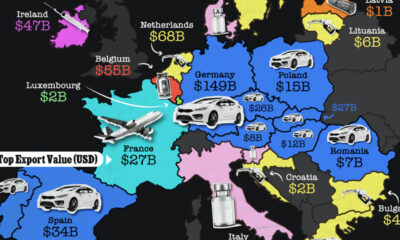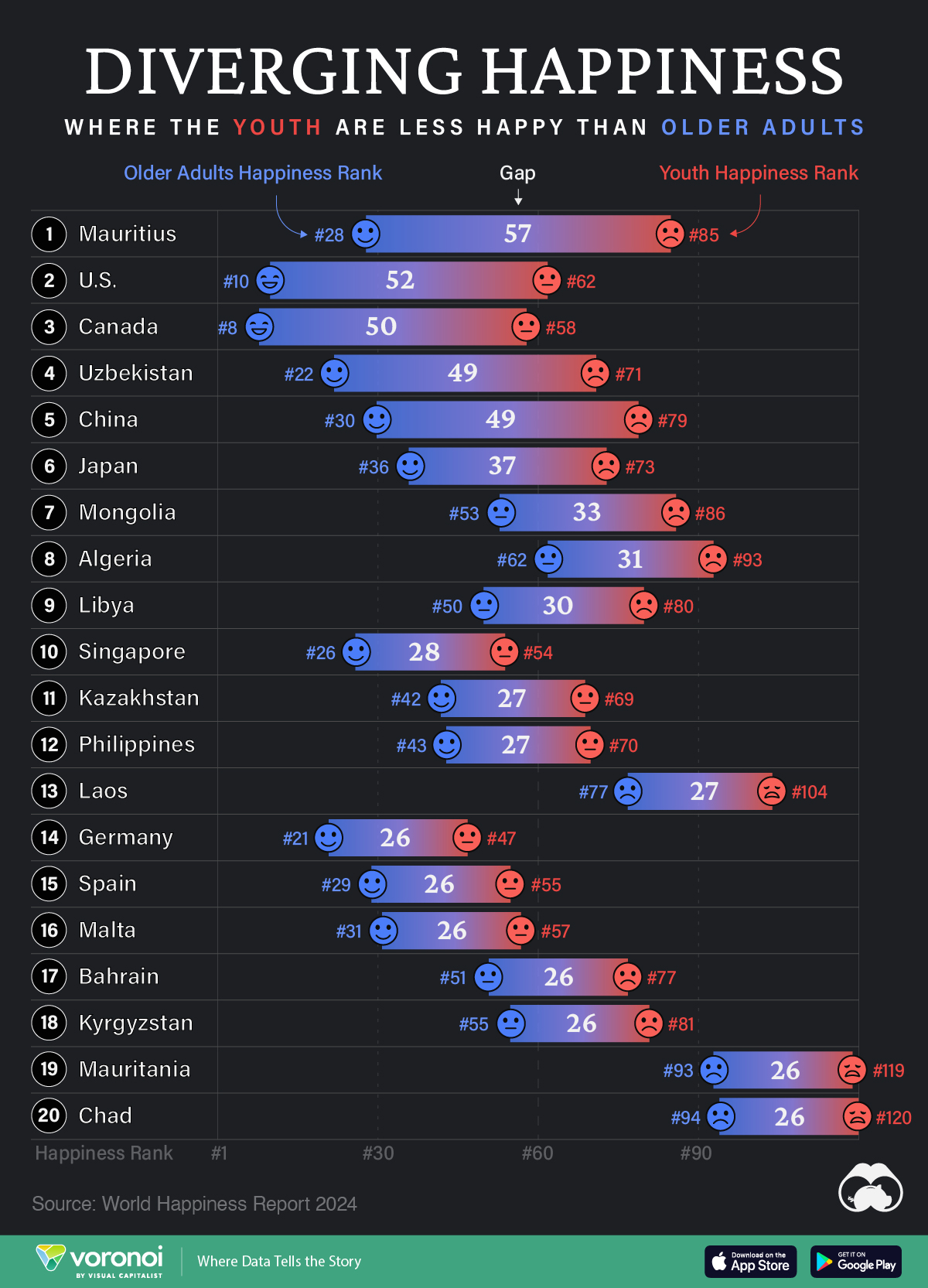Countries
Charted: The Number of Democracies Globally
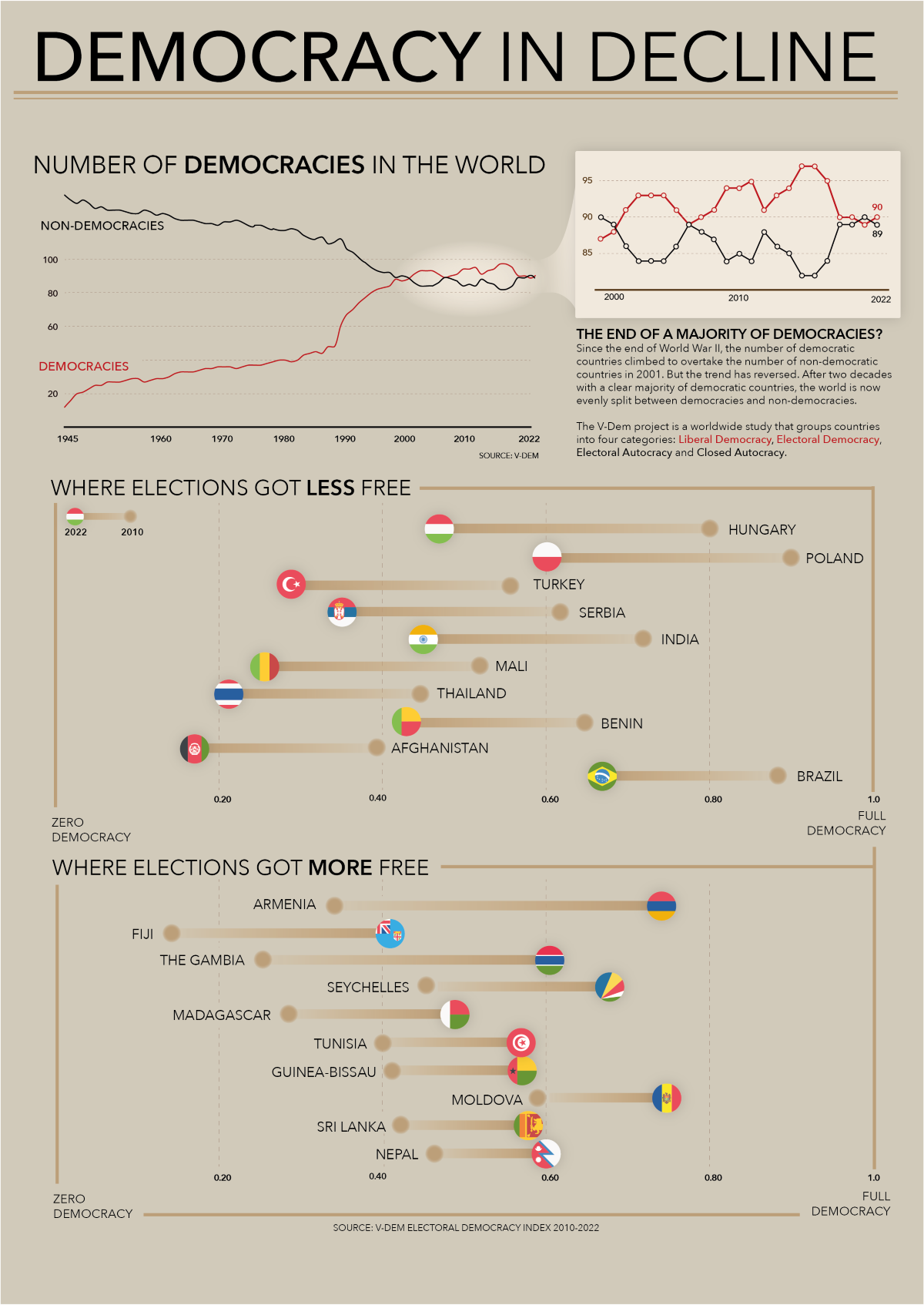
Charted: The Number of Democracies Globally
The end of World War II in 1945 was a turning point for democracies around the world.
Before this critical turning point in geopolitics, democracies made up only a small number of the world’s countries, both legally and in practice. However, over the course of the next six decades, the number of democratic nations would more than quadruple.
Interestingly, studies have found that this trend has recently reversed as of the 2010s, with democracies and non-democracies now in a deadlock.
In this visualization, Staffan Landin uses data from V-DEM’s Electoral Democratic Index (EDI) to highlight the changing face of global politics over the past two decades and the nations that contributed the most to this change.
The Methodology
V-DEM’s EDI attempts to measure democratic development in a comprehensive way, through the contributions of 3,700 experts from countries around the world.
Instead of relying on each nation’s legally recognized system of government, the EDI analyzes the level of electoral democracy in countries on a range of indicators, including:
- Free and fair elections
- Rule of law
- Alternative sources of information and association
- Freedom of expression
Countries are assigned a score on a scale from 0 to 1, with higher scores indicating a higher level of democracy. Each is also categorized into four types of functional government, from liberal and electoral democracies to electoral and closed autocracies.
Which Countries Have Declined the Most?
The EDI found that numerous countries around the world saw declines in democracy over the past two decades. Here are the 10 countries that saw the steepest decline in EDI score since 2010:
| Country | Democracy Index (2010) | Democracy Index (2022) | Points Lost |
|---|---|---|---|
| 🇭🇺 Hungary | 0.80 | 0.46 | -34 |
| 🇵🇱 Poland | 0.89 | 0.59 | -30 |
| 🇷🇸 Serbia | 0.61 | 0.34 | -27 |
| 🇹🇷 Türkiye | 0.55 | 0.28 | -27 |
| 🇮🇳 India | 0.71 | 0.44 | -27 |
| 🇲🇱 Mali | 0.51 | 0.25 | -26 |
| 🇹🇭 Thailand | 0.44 | 0.20 | -24 |
| 🇦🇫 Afghanistan | 0.38 | 0.16 | -22 |
| 🇧🇷 Brazil | 0.88 | 0.66 | -22 |
| 🇧🇯 Benin | 0.64 | 0.42 | -22 |
Central and Eastern Europe was home to three of the countries seeing the largest declines in democracy. Hungary, Poland, and Serbia lead the table, with Hungary and Serbia in particular dropping below scores of 0.5.
Some of the world’s largest countries by population also decreased significantly, including India and Brazil. Across most of the top 10, the “freedom of expression” indicator was hit particularly hard, with notable increases in media censorship to be found in Afghanistan and Brazil.
Countries Becoming More Democratic
Here are the 10 countries that saw the largest increase in EDI score since 2010:
| Country | Democracy Index (2010) | Democracy Index (2022) | Points Gained |
|---|---|---|---|
| 🇦🇲 Armenia | 0.34 | 0.74 | +40 |
| 🇫🇯 Fiji | 0.14 | 0.40 | +26 |
| 🇬🇲 The Gambia | 0.25 | 0.50 | +25 |
| 🇸🇨 Seychelles | 0.45 | 0.67 | +22 |
| 🇲🇬 Madagascar | 0.28 | 0.48 | +20 |
| 🇹🇳 Tunisia | 0.40 | 0.56 | +16 |
| 🇱🇰 Sri Lanka | 0.42 | 0.57 | +15 |
| 🇬🇼 Guinea-Bissau | 0.41 | 0.56 | +15 |
| 🇲🇩 Moldova | 0.59 | 0.74 | +15 |
| 🇳🇵 Nepal | 0.46 | 0.59 | +13 |
Armenia, Fiji, and Seychelles saw significant improvement in the autonomy of their electoral management bodies in the last 10 years. Partially as a result, both Armenia and Seychelles have seen their scores rise above 0.5.
The Gambia also saw great improvement across many election indicators, including the quality of voter registries, vote buying, and election violence. It was one of five African countries to make the top 10 most improved democracies.
With the total number of democracies and non-democracies almost tied over the past four years, it is hard to predict the political atmosphere in the future.

This article was published as a part of Visual Capitalist's Creator Program, which features data-driven visuals from some of our favorite Creators around the world.
Demographics
Ranked: Countries Where Youth are the Most Unhappy, Relative to Older Generations
Conventional wisdom says that young adults (those below 30) tend to be the happiest demographic—but this is not true for these countries.
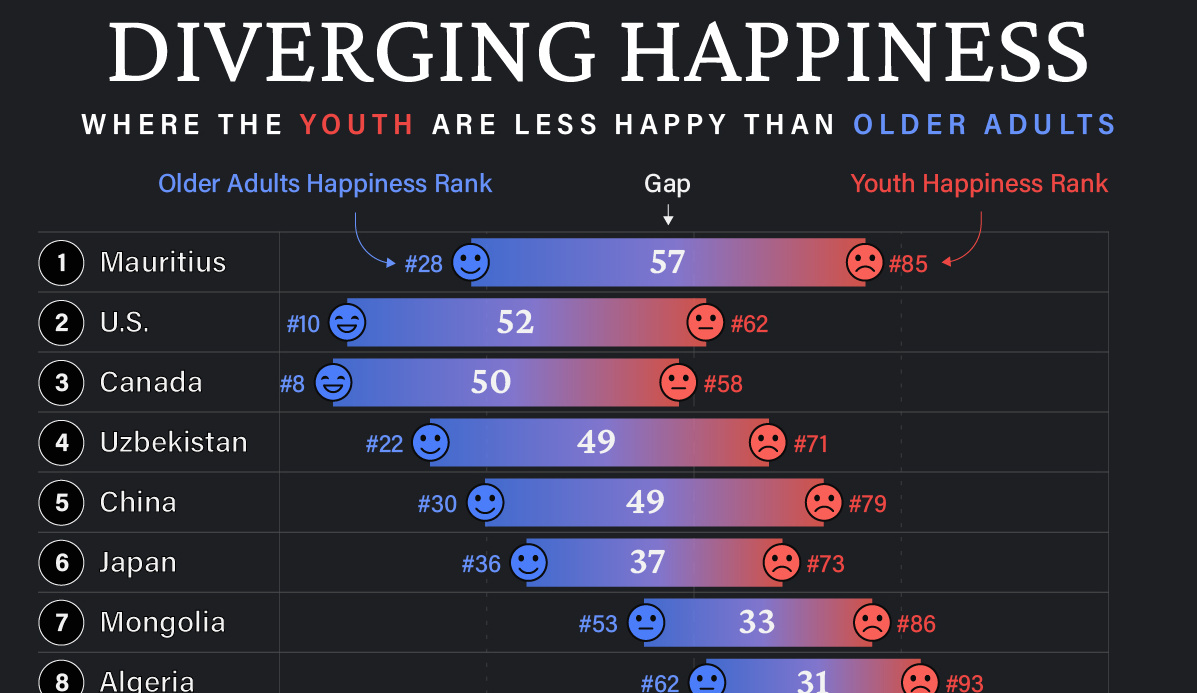
Countries with the Biggest Happiness Gaps Between Generations
This was originally posted on our Voronoi app. Download the app for free on iOS or Android and discover incredible data-driven charts from a variety of trusted sources.
“They say a person needs just three things to be truly happy in this world: someone to love, something to do, and something to hope for.” — Tom Bodett
Measuring happiness is tricky business, more so when taking into account how different regions, cultures, and faiths define it. Nevertheless, the World Happiness Report attempts to distill being happy into a single score out of 10, and then ranks countries by their average score.
We’ve visualized the high-level findings from the latest happiness report in this series of maps. However, the report also dives deeper into other significant trends in the data, such as a growing disparity in happiness between age groups within countries themselves.
In the chart above, we list countries by the biggest gaps in happiness ranks between young adults (<30) and older adults (60+). A higher number indicates a larger gap, and that the youth are far unhappier than their older counterparts.
Where are Youth Unhappier than Older Adults?
Mauritius ranks first on this list, with a massive 57 place gap between older adult and youth happiness. The 1.26 million-inhabited island nation briefly reached high income status in 2020, but the pandemic hit hard, hurting its key tourism sector, and affecting jobs.
The country’s youth unemployment rate spiked to close to 25% that year, but has since been on the decline. Like residents on many similarly-populated islands, the younger demographic often moves abroad in search of more opportunities.
| Rank | Country | Youth Happiness Rank | Older Adult Happiness Rank | Happiness Gap |
|---|---|---|---|---|
| 1 | 🇲🇺 Mauritius | 85 | 28 | 57 |
| 2 | 🇺🇸 U.S. | 62 | 10 | 52 |
| 3 | 🇨🇦 Canada | 58 | 8 | 50 |
| 4 | 🇺🇿 Uzbekistan | 71 | 22 | 49 |
| 5 | 🇨🇳 China | 79 | 30 | 49 |
| 6 | 🇯🇵 Japan | 73 | 36 | 37 |
| 7 | 🇲🇳 Mongolia | 86 | 53 | 33 |
| 8 | 🇩🇿 Algeria | 93 | 62 | 31 |
| 9 | 🇱🇾 Libya | 80 | 50 | 30 |
| 10 | 🇸🇬 Singapore | 54 | 26 | 28 |
| 11 | 🇰🇿 Kazakhstan | 69 | 42 | 27 |
| 12 | 🇵🇭 Philippines | 70 | 43 | 27 |
| 13 | 🇱🇦 Laos | 104 | 77 | 27 |
| 14 | 🇩🇪 Germany | 47 | 21 | 26 |
| 15 | 🇪🇸 Spain | 55 | 29 | 26 |
| 16 | 🇲🇹 Malta | 57 | 31 | 26 |
| 17 | 🇧🇭 Bahrain | 77 | 51 | 26 |
| 18 | 🇰🇬 Kyrgyzstan | 81 | 55 | 26 |
| 19 | 🇲🇷 Mauritania | 119 | 93 | 26 |
| 20 | 🇹🇩 Chad | 120 | 94 | 26 |
Conventional wisdom says, and data somewhat correlates, that young adults (those below 30) tend to be the happiest demographic. Happiness then decreases through middle age and starts increasing around 60. However, the above countries are digressing from the pattern, with older generations being much happier than young adults.
That older generations are happier, by itself, is not a bad thing. However, that younger adults are so much unhappier in the same country can point to several unique stresses that those aged below 30 are facing.
For example, in the U.S. and Canada—both near the top of this list—many young adults feel like they have been priced out of owning a home: a once key metric of success.
Climate anxieties are also high, with worries about the future of the world they’ll inhabit. Finally, persistent economic inequities are also weighing on the younger generation, with many in that cohort feeling like they will never be able to afford to retire.
All of this comes alongside a rising loneliness epidemic, where those aged 18–25 report much higher rates of loneliness than the general population.
Source: The World Happiness Report which leverages data from the Gallup World Poll.
Methodology: A nationally representative group of approximately 1,000 people per country are asked to evaluate their life on a scale of 0–10. Scores are averaged across generations per country over three years. Countries are ranked by their scores out of 10.
-

 Technology1 week ago
Technology1 week agoVisualizing the 5 Most Common Cybersecurity Mistakes
-

 Maps2 weeks ago
Maps2 weeks agoMapped: U.S. States By Number of Cities Over 250,000 Residents
-

 Crime2 weeks ago
Crime2 weeks agoVisualizing Global Losses from Financial Scams
-
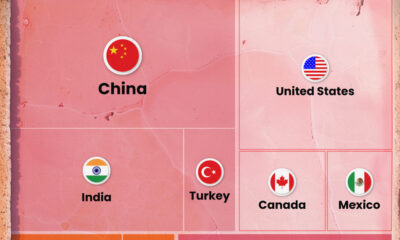
 Mining2 weeks ago
Mining2 weeks agoThe Biggest Salt Producing Countries in 2023
-

 Markets2 weeks ago
Markets2 weeks agoRanked: The Top 6 Economies by Share of Global GDP (1980-2024)
-
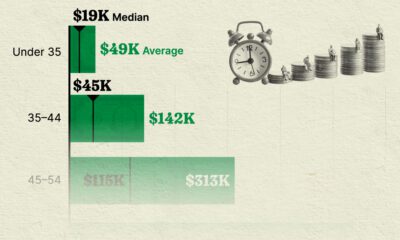
 Money2 weeks ago
Money2 weeks agoVisualizing America’s Average Retirement Savings, by Age
-
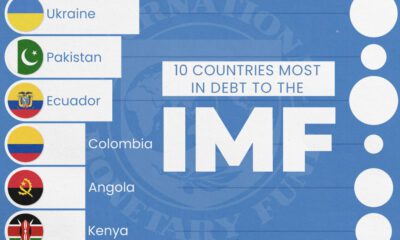
 Markets2 weeks ago
Markets2 weeks agoTop 10 Countries Most in Debt to the IMF
-
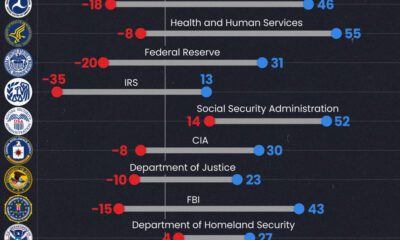
 Politics2 weeks ago
Politics2 weeks agoCharted: How Democrats and Republicans View Government Agencies




